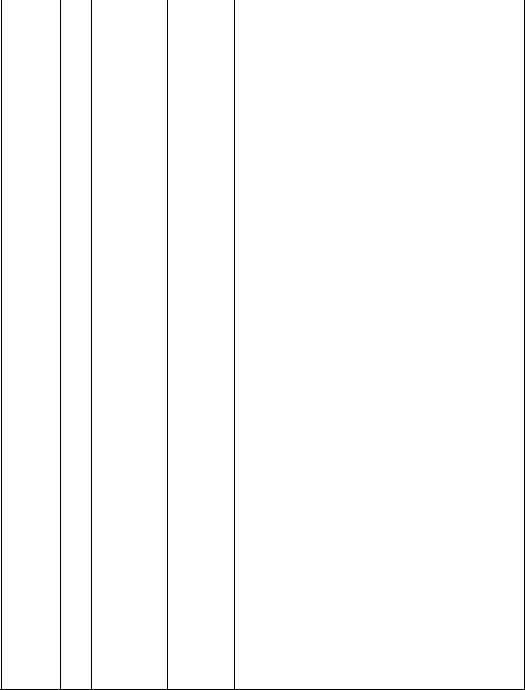Alinco DR-130 Schematic

DR-130
Service Manual
CONTENTS |
|
|
|
|
|
SPECIFICATIONS |
|
|
|
|
|
1) |
General |
2 |
PARTS LAST |
|
|
2) |
Transmitter |
2 |
MAIN Unit |
22-23 |
|
3) |
Receiver |
2 |
CPU Unit |
24 |
|
CIRCUIT DESCRIPTION |
|
VCO Unit |
25 |
||
1) |
Receiver System |
3 |
SP Unit |
25 |
|
2) |
Transmitter System |
4 |
EJ19u. |
25 |
|
3) |
PLL Circuit |
4 |
Mechanical Parts |
25 |
|
4) |
Terminal Function of Microprocessor |
5 - 7 |
Others |
25 |
|
5) |
Terminal Connection of Microprocessor |
8 |
Packing.. |
25 |
|
SEMICONDUCTOR DATA |
|
EJ20u |
26 |
||
1) |
AK2341 |
9 |
EMS-5A |
26 |
|
2) |
AN78LO5M |
10 |
EMS-11 |
26 |
|
3) |
AN8010M |
10 |
ADJUSTMENT |
|
|
4) |
BU4052BF |
10 |
1) |
Required Test Equipment. |
27 |
5) |
LR408721 |
11 |
2) |
Adjustment for DR-130 |
28~29 |
6) |
M5218FP |
11 |
3) |
Adjustment Points |
30 |
7) |
M56760FP |
12 |
4) |
Adjustment Quick Reference |
30 |
8) |
MC7808CT |
13 |
CIRCUIT DIAGRAM |
|
|
9) |
RH5VA32AA-T1 |
13 |
1) EMS-5A |
31 |
|
10) |
RH5VA45AA-T1 |
13 |
2) EMS-11 |
31 |
|
11) |
S-AV17 |
14 |
3) |
Main Unit (T/E/EZ/EA/TA) |
32 |
12) |
TK10487MTR |
15 |
4) |
Main Unit (TEl1/TE2) |
33 |
13) |
AT24CO2N-10SI-2.7 |
15 |
5) |
CPU Unit |
34 |
14) |
AT24CO8-10SI-2.7 |
15 |
PC BOARD VIEW |
|
|
15) |
uPC1241H |
16 |
1) |
Main Unit Side A |
35 |
16) |
Transistor, Diode and LED Outline Drawings |
16 |
2) |
Main Unit Side B |
36 |
17) |
LCD Connection |
17 |
3) |
CPU Unit Side A. |
37 |
EXPLODED VIEW |
|
4) CPU Unit Side B |
37 |
||
1) |
Bottom View |
18 |
5) |
VCO Unit Side A |
38 |
2) |
LCD View |
18 |
6) VCO Unit Side B |
38 |
|
3) |
Top, Front View 1 |
19 |
BLOCK DIAGRAM |
39 |
|
4) |
Top, Front View 2 |
20 |
|
|
|
VERSION TABLE |
21 |
|
|
|
|
ALINCO INCORPORATED
TWIN 21 M.I.D. TOWER BUILDING 23F, 1-61, 2-CHOME,
SHIROMI CHUO-KU , OSAKA, 540-8580 JAPAN
Tel (81)6-6946-8150 fax (81)6-6946-8175 e-mail: export@alinco.co.jp
SPECIFICATIONS
1) General |
|
|
|
Frequency Coverage: |
RX: 136.000 ~ 174.000MHz |
(T version) |
|
|
|||
|
TX: 144.000 ~ 148.000MHz |
(T version) |
|
|
RX: 144.000 ~ 146.000MHz |
(E/EZ version) |
|
|
TX: 144.000 ~ 146.000MHz |
(E/EZ version) |
|
|
RX: 130.000 ~ 174.000MHz |
(EA/TA version) |
|
|
TX: 130.000 ~ 174.000MHz |
(EA/TA version) |
|
|
RX: 136.000 ~ 155.000MHz |
(TE1 version) |
|
|
TX: 136.000 ~ 155.000MHz |
(TE1 version) |
|
|
RX: 150.000 ~ 174.000MHz |
(TE2 version) |
|
|
TX: 150.000 ~ 174.000MHz |
(TE2 version) |
|
Frequency Resolution: |
5, 10, 12.5, 15,20,25kHzsteps |
|
|
Antenna Impedance: |
50 ohm unbalanced |
|
|
Power Supply Requirements: DC 13.8 +/-10% Volts DC |
|
||
Current Drain at l3.8V |
Receiving: Squelched less than 800mA |
||
|
|||
|
Transmitting: High/10.0A (approx.) |
||
|
|
Low/3.5A (approx.) |
|
Dimensions: |
140mm(W) x 40mm(H) x 154mm(D) |
||
Weight: |
0.86kg (approx.) |
|
|
2) Transmitter |
High: 50Watts (DR-130T/E) |
|
|
Output Power: |
High: 35Watts (DR-130TE1/2) |
|
|
|
High:10Watts (DR-130EZ) |
|
|
|
Low: 5Watts (Approx.) |
|
|
Emission Mode: |
F3E(FM) |
|
|
Modulation System: |
Variable Reactance Frequency Modulation |
||
Max. Frequency Deviation: |
+/ -5kHz |
(Wide Version) |
|
|
+/ -2.5kHz |
(Narrow Version) |
|
Spurious Emission: |
-60dB or below carrier |
|
|
Microphone: |
Electret Condenser Microphone |
||
Operating Mode: |
Simplex/Semi-Duplex |
|
|
Offset : |
0ffset from 0 to 15.995MHz |
|
|
3) Receiver |
|
|
|
Receiving System: |
Superheterodyne Dual Conversion |
||
Intermediate Frequency: |
1stIF: 17.2MHz |
|
|
|
2nd lF: 455kHz |
|
|
|
12dB SINAD less than -l6dBu (144.000MHz ~ 147.995MHz) |
||
Sensitivity: |
More than +/-6kHz at -6dB |
(Wide Version) |
|
Selectivity: |
Less than +/-15kHz at -60dB |
(Wide Version) |
|
Audio Power Output: |
More than 2.5W 10% Distortion |
||
Speaker Impedance: |
8 ohm |
|
Page-2 |
|
|
|
|
CIRCUIT DESCRTPTION
1) Receiver System
1. Front End
The signal from the antenna is passed through a low-pass filter and input to the voltage step up circuit consisting Of L14. The signal from L14 is led to the gate of Q1. D19 is the diode limiter circuit against the excessive input power of more than 20dBm. Q1 is the FETwhich has two gates. The voltage of the gate 2 is set higher to get the high gain and sensitivity. The signal from Q1 is led to the triple band pass filter (L4, L5, L6), and gets the high image rejection ratio.
2. Mixer Circuit
The signal from the triple band pass filter is converted into the first lF signal of 17.2MHz. The receiving signal is led to the gate 1 of Q2, and the first local oscillator signal is led to the gate 2 of Q2. To get the high conversion gain, the local oscillator signal voltage is set to about 1V. To reduce the high adjacent channel interference, the band width of the FL2 is set to 20kHz. The signal from FL2 is amplified by Q8, and input to FM IF system IC3 of TK10487.
3. lF Circuit
The TK10487 has the second local oscilltor circuit, mixer circuit, detector circuit, squelch circuit, and so on. Pin1 and 2 are the terminals of the crystal oscillator circuit. Pin2 (emitter) is connected to the ground via the resister R3 to prevent the oscillator from decreasing the power at the low temperature. Pin4 of IC3 is connected to FL1 directly because the matching resistor for ceramic filter is built-in. The quadrature circuit (pin10 of IC3) is connected to the ceramic resonator X2 for the temperature stability and good quality. The signal from pin11 of IC3 is connected to the LPF. The detected AF signal, which has flat frequency characteristics, is led to the control unit and used as both squelch signal and tone squelch signal. De-emphasis circuit consists of R31, R32, C26 and C27. The LPF amplifier consisting of Q5 and Q6 is located far away from the VR in the control unit, so it outputs the high voltage signal to prevent S/N from the deterioration. The squelch switch circuit consists of Q4 and Q16, and switches on/off at the point where there is no voltage to prevent from the switching noise. The S meter signal from pin12 of IC3 is led to the CPU in the control unit after adjusting the level at D20 and VR5. The S meter signal is thermal compensated by TH1 and stabilized. The noise amplifier consists of pin13 and 14, the built-in OP amplifier in IC3. The output signal of noise amplifier is amplified by Q14, rectified by D5, and then led to the pin15 (hysteresis comparator input) of IC3.
4. AF Circuit
IC4 is about 5W audio power amplifier IC. When the capacity of pin1 in C16 is increased more, the output incidental noise becomes smaller. The highpitched tone becomes smaller at the same time, This radio's capacity of C16 is determined considering the high-pitched tone.
Page-3
2)Transmitter System
1.Modulation Circuit
3)PLL Circuit
The microphone amplifier IC1 (IDC, LPF) consists of two operational amplifiers. The signal from the microphone is led to pre-emphasis circuit consisting of C36 and R47 and then to the limiter circuit. The limiter circuit uses the saturation of the OP amplifier. The amplified signal is input to the low-pass filter IC1A. The output signal from the microphone amplifier is passed through variable resistors VR2 for modulatlon adjustment and input to the VCO unit. Sub tone deviation is determined by R24, R25 and VR2. The radio does not have the adjustment variable resistor for sub tone deviation.
2. TX Amp. Circuit
The signal from VCO is ampriied by TX, RX wide band LO amplifier Q19. The signal from Ql9 is passed through the transmission/reception selector, and amplified byQ20 and Q15. The PA unit is driven at 200mW driving power.
3. PA Circuit
IC5 is 50W powered amplifier module. The output power is controlled by the voltage ofV1. The RF signal amplified 50W in PA is passed through D3 and three-stage transmission/reception low-pass filter, and input to the antenna connector.
4. ALC Circuit
The power detection circuit consisting of D17 and D18 rectifies the output signal voltage. The detected DC voltage is led to the VR1 (power adjust trimmer), and amplified by Q3, Q9 and Ql3. Output power is controlled by voltage of V1 in lC5 and collector voltage of Ql5. When the temperature goes up unusually, the power down circuit consisting of R101 and TH2 works to prevent the device from the destruction.
The VCO unit is designed for the PLL circuit, putting the VCO on one side, and PLL circuit on the other side.
Q301 in the VCO is grounded using the gate oscmator, and its frequency covers 134MHz to 174MHz without transmission/reception shift circuit. lC301 is pulse swallow system based PLL IC with the built-in prescaler, which synthesizes 150MHzlband signal.
The loop filter consisting of Q302 and Q303 is the active type.
Page-4

4) Terminal Function of Microprocessor
Port No. |
I/O |
Logic |
PinName Description |
|
|
|
|
|
|
1 |
O |
|
SEG19 |
LCDSegment19 Output |
2 |
O |
|
SEG20 |
LCDSegment20 Output |
3 |
O |
|
SEG21 |
LCDSegment21 Output |
4 |
O |
|
SEG22 |
LCDSegment22 Output |
5 |
O |
|
SEG23 |
LCDSegment23 Output |
6 |
I |
|
GND |
AnalogGround 0V |
7 |
I |
|
Vref |
Reference Voltage Input 5V |
8 |
I |
|
Vcc |
CPU Power Supply hnput 5V |
9 |
O |
|
1750_ |
ToneBurstOutput |
10 |
O |
Clock |
BEEP |
BeepToneOutput |
11 |
I |
Active Low MUP |
Channel Up Input (Microphone Control) |
|
12 |
I |
Active Low MDN |
Channel Down Input (Microphone Control) |
|
13 |
I |
NoUse |
EID |
|
14 |
O |
Active Low SQL |
Squelch Control (L: Audio is off.) |
|
15 |
O |
ActiveHigh MUT |
Microphone Mute (H: Mic Amp is off.) |
|
16 |
I |
Active Low REl |
RotaryEncoder Input |
|
17 |
O |
Clock |
TO3 |
ToneOutput |
18 |
O |
Clock |
TO2 |
ToneOutput |
19 |
O |
Clock |
TO1 |
ToneOutput |
20 |
O |
Clock |
TO0 |
ToneOutput |
21 |
I |
ActiveHigh XWR |
EEPROM Write Status External Input |
|
22 |
I |
Active Low RE2 |
RotaryEncoder Input |
|
23 |
O |
Active Low BPO |
Band Plan Detection Input (Common) |
|
24 |
I |
Active Low TID |
Tone Unit Detection Input |
|
25 |
I |
Active Low BU |
Back Up Signal Detection input |
|
26 |
I |
|
GND |
Ground |
27 |
l |
Active Low RST |
ResetInput |
|
28 |
I |
|
Xin |
Crystal Oscillator Terminal (3.58MHz) |
29 |
O |
|
Xout |
Crystal Oscillator Terminal (3.58MHz) |
30 |
I |
|
GND |
Ground |
31 |
I |
Active Low TDO |
CTCSS Tone Detection Output |
|
32 |
O |
Active High DTD |
For Trunking |
|
33 |
O |
NoUse |
|
|
34 |
I |
Active Low DD4 |
Band Plan 4 (V/U Selection) |
|
35 |
I |
Active Low DD3 |
Band Plan 3 (445/435 Selection) |
|
36 |
I |
Active Low DD2 |
Band Plan 2 (5k/12.5k Selection) |
|
37 |
I |
Active Low DD1 |
Band Plan 1 |
|
38 |
I |
Active Low DD0 |
Band Plan 0 |
|
39 |
O |
Clock |
SCL |
Clock Output for EEPROM |
Page-5
Port No. |
I/O |
Logic |
PinName |
Description |
|
|
|
|
|
40 |
I/O |
Clock |
SDA |
Data Output for EEPROM |
41 |
O |
Clock |
CLK |
Clock Output |
42 |
O |
Clock |
DAT |
DataOutput |
43 |
O |
Clock |
ST1 |
Strobe Output for PLL IC |
44 |
O |
Clock |
ST2 |
Strobe Output for CTCSS IC |
45 |
I |
Active Low |
SFT |
Shift Key Input |
46 |
I |
Active High |
SD |
Signal Detection Input |
47 |
O |
Active High |
H/L |
Transmission Power (H: Low Power) |
48 |
I |
Active Low |
V/M |
VFO/Memory Key Input |
49 |
I |
Active Low |
CAL |
Call Key Input |
50 |
I |
Active Low |
CTC |
CTCSS Mode Set Input |
51 |
I |
Active Low |
REV |
Reverse Key Input |
52 |
I |
Active Low |
FNC |
Function Key Input |
53 |
I |
Active Low |
MHz |
MHzKeyInput |
54 |
I |
Active Low |
PTT |
PTTKeyInput |
55 |
I |
|
LV3 |
Power Supply Input for LCD |
56 |
I |
|
LV2 |
Power Supply Input for LCD |
57 |
I |
|
LV1 |
Power Supply Input for LCD |
58 |
I |
|
COM0 |
LCD Common 0 Output |
59 |
I |
|
COM1 |
LCD Common 1 Output |
60 |
I |
|
COM2 |
LCD Common 2 Output |
61 |
I |
No Use |
|
|
62 |
O |
|
SEG00 |
LCD Segment 00 Output |
63 |
O |
|
SEG01 |
LCD Segment 01 Output |
64 |
O |
|
SEG02 |
LCD Segment 02 Output |
65 |
O |
|
SEG03 |
LCD Segment 03 Output |
66 |
O |
|
SEG04 |
LCD Segment 04 Output |
67 |
O |
|
SEG05 |
LCD Segment 05 Output |
68 |
O |
|
SEG06 |
LCD Segment 06 Output |
69 |
O |
|
SEG07 |
LCD Segment 07 Output |
70 |
O |
|
SEG08 |
LCD Segment 08 Output |
71 |
O |
|
SEG09 |
LCD Segment 09 Output |
72 |
O |
|
SEG10 |
LCD Segment 10 Output |
73 |
O |
|
SEG11 |
LCD Segment 11 Output |
74 |
O |
|
SEG12 |
LCD Segment 12 Output |
75 |
O |
|
SEG13 |
LCD Segment 13 Output |
76 |
O |
|
SEG14 |
LCD Segment 14 Output |
77 |
O |
|
SEG15 |
LCD Segment 15 Output |
78 |
I |
ActiveHigh |
UL |
UnlockInput |
79 |
I |
Analog |
SM |
SignalMeterInput |
80 |
O |
|
SEG18 |
LCD Segment 18 Output |
|
|
|
|
|
Page-6

Page-8

Page-9

Page-10

Page-11

Page-12

Page-13
